This article was published in Scientific American’s former blog network and reflects the views of the author, not necessarily those of Scientific American
A huge quantity of evidence shows that birds are dinosaurs, and specifically a lineage of the coelurosaurian theropod group Maniraptora. Additional support for the coelurosaurian origin of birds arrives on a regular basis, since new Jurassic and Cretaceous fossil species that fit somewhere on the bird lineage are reported virtually every month. But… I can’t help but be interested in ‘non-standard’ or ‘alternative’ hypotheses on evolutionary history, and among the most interesting is the ‘Birds Are Not Dinosaurs’ (or BAND) movement. It’s made “among the most interesting” by the fact that its proponents have seen themselves as crusaders, true sceptics and better scientists than those who support what is now the mainstream model; they’ve – I think unwittingly – moulded themselves into a distinct social group, even going so far as wearing special badges at conferences. Back in 2012 I wrote a long chapter on the evolutionary history of birds (Naish 2012), and I thought it would be remiss to exclude a section on the BAND movement. That section is reproduced here…
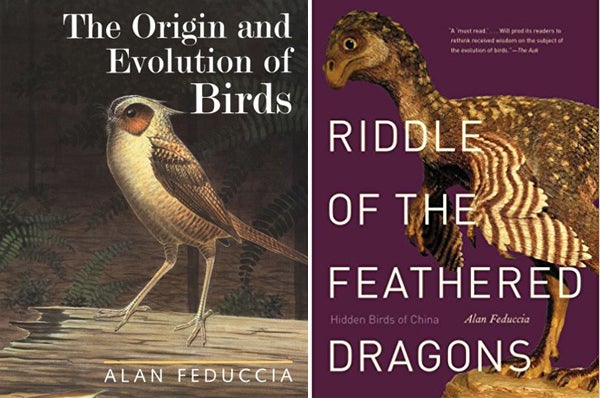
Alan Feduccia's books are by far the best known sources for the 'Birds Are Not Dinosaurs' arguments. 'Riddle of the Feathered Dragons' is such a terrible (and terribly misleading) title. Credit: Yale University Press (left); Yale University Press (right)
The theropod hypothesis of bird origins is not universally accepted. Some ornithologists and paleontologists argue that theropods cannot be ancestral to birds because they do not conform, in anatomy or lifestyle, to the true bird ancestor as imagined by these researchers. Supposedly, theropods are too large and too specialized for terrestrial cursoriality to give rise to birds, possess anatomical characters that bar them from avialan ancestry, and appear too late in the Mesozoic record to be ancestral to Archaeopteryx (e.g., Martin 1983; Feduccia 1996, 2002). These authors argue that a number of peculiar Triassic reptiles – they include Megalancosaurus, Cosesaurus, and Longisquama and have been dubbed avimorph thecodonts – might represent the real closest relatives of birds. None of these taxa is at all birdlike and all clearly belong elsewhere in reptile phylogeny.
On supporting science journalism
If you're enjoying this article, consider supporting our award-winning journalism by subscribing. By purchasing a subscription you are helping to ensure the future of impactful stories about the discoveries and ideas shaping our world today.
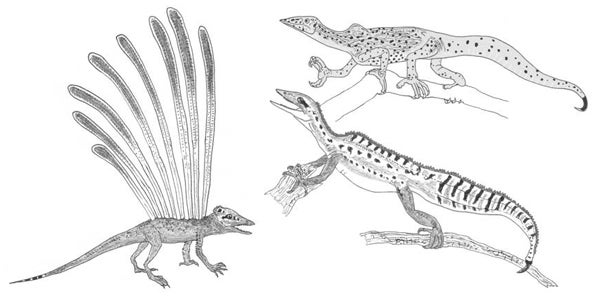
BANDit scientists have pointed to these animals - bizarre Longisquama (at left) and the climbing megalancosaurs - as 'better' bird ancestors than theropod dinosaurs. They're about as different from birds as you could imagine. Credit: Darren Naish
The objections proposed by these workers have never been a problem for the theropod hypothesis and are naive attempts to falsify a well-supported hypothesis. While the Jurassic record of small theropods is poor, numerous fossils (among the best are those of the Middle and Late Jurassic maniraptorans Anchiornis and Xiaotingia) show that deinonychosaurs and other maniraptorans were present before the Tithonian (that is, they are geologically older than Archaeopteryx). Furthermore, non-avialan maniraptorans were not all large (some deinonychosaurs and other maniraptorans were similar in size to, or smaller than, Archaeopteryx), nor do claims that they were fundamentally distinct from basal birds withstand scrutiny.

Mesozoic maniraptoran dinosaurs that possess all kinds of bird-like and not-so-bird-like combinations of anatomical characters are published all the time. This reconstruction, by Emily Willoughby, depicts Serikornis from the Upper Jurassic of China. According to its describers, it is not a bird. Credit: Emily Willoughby Wikimedia (CC BY-SA 4.0)
It has been argued that the neornithine hand represents digits II–IV and is therefore different from the maniraptoran hand, which is usually taken to represent digits I–III. It seems peculiar to argue that a single character, or even a complex of related characters, can trump a list of tens or hundreds of others. The strong character evidence nesting birds within coelurosaurs must mean either that the proposed II–IV formula for the avialan hand is wrong, or that an unusual embryological event – a so-called frameshift – occurred in theropod evolution. If such a frameshift did occur, true digit I was lost and true digit II became digit I. However, evidence from Hox genes indicates that the condensation axis for the first embryonic hand digit in birds receives a Hox signal normally associated with digit I (Vargas and Fallon 2005). This shows that the avialan hand likely does represent digits I–III.
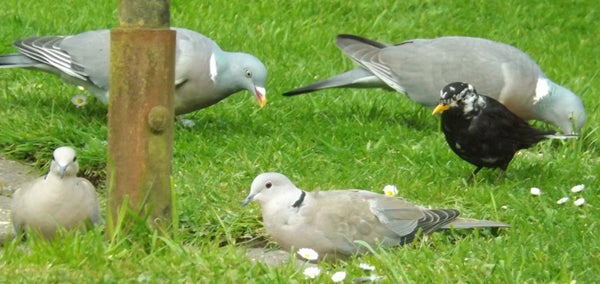
Some BANDit scientists have (apparently seriously) stated that those scientists who support a dinosaurian origin for birds "just don't know birds". This is unfair and not at all true. In fact, the modern study of fossil birds is increasingly populated by people who agree with or support the idea that birds are dinosaurs. Here's a photo of some birds. Credit: Darren Naish
Overall, the “birds are not dinosaurs” movement can be dismissed as naive because it hinges on the idea that we should make predictions about the avian ancestor before looking at fossils or phylogeny. Evolutionary hypotheses should be formulated on phylogenies, not vice versa.
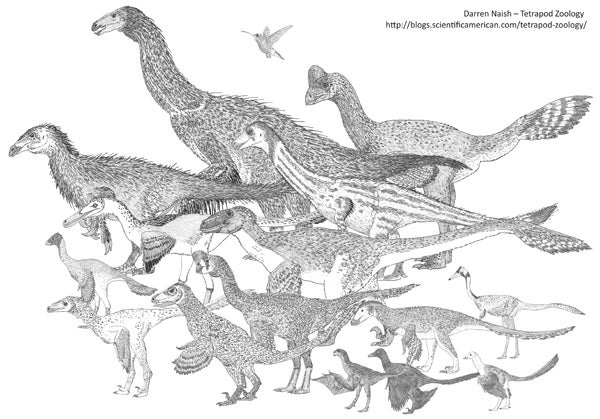
Alan Feduccia and his colleagues would have it that some of these animals are large flightless birds (indeed, some may well be), whereas others are nothing whatsoever to do with the bird lineage and not at all close to it in evolutionary terms. The reality is that theropods show exactly what we would predict given that birds evolved from among them: some are only vaguely bird-like, others are somewhat bird-like, others are highly bird-like, and others are so close to birds that we argue over whether they're birds or not. Credit: Darren Naish
Because vaned feathers are known for deinonychosaurs and oviraptorosaurs, Feduccia and colleagues have more recently argued that feathered maniraptorans are secondarily flightless members of Avialae, thereby renouncing decades of argumentation in which they stated that deinonychosaurs have no close relationship with birds (Feduccia 2002; Martin 2004; Feduccia et al. 2007). This idea of secondary flightlessness is not wholly objectionable, and some supporters of the theropod hypothesis have argued similarly (Paul 2002), but it is not supported by large analyses that incorporate good sampling of characters and taxa. Furthermore, what makes the hypothesis of Feduccia et al. untenable is their corollary that this feathered maniraptoran clade has no close affinity with the rest of Dinosauria. It is difficult to take this seriously, given that non-avialan maniraptorans have obvious affinities with non-maniraptoran coelurosaurs, which in turn have affinities with non-coelurosaurian theropods, and so on.
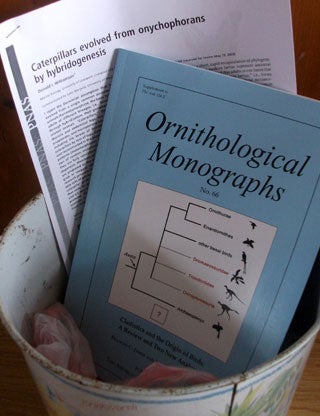
I regret that I was not a fan of this study. Credit: Darren Naish
A cladistic analysis that found no strong support for the theropod affinities of birds (James and Pourtless 2009) is extremely flawed. This study excluded all characters where homology has been questioned and excluded nontheropodan dinosaurs. Furthermore, the phylogenies generated by James and Pourtless (2009) are unresolved polytomies, so it cannot be said that this study failed to find support for the theropod hypothesis in particular; it actually failed to find support for any hypothesis! While some details of maniraptoran phylogenies may prove incorrect, the “birds are not theropods” movement is based on erroneous argumentation and fails to account for the data as well as the theropod hypothesis does.
For previous Tet Zoo articles relevant to the issues covered here, see…
Luis Chiappe’s Glorified Dinosaurs: The Origin and Early Evolution of Birds
Did Velociraptor and Archaeopteryx climb trees? Claws and climbing in birds and other dinosaurs
Yi qi Is Neat But Might Not Have Been the Black Screaming Dino-Dragon of Death
The Integrated Maniraptoran, Part 3: Feathers Did Not Evolve in an Aerodynamic Context
Refs - -
Feduccia, A. 1996. The Origin and Evolution of Birds. New Haven, Conn., Yale University Press.
Feduccia, A. 2002. Birds are dinosaurs: simple answer to a complex problem. Auk 119, 1187-1201.
Feduccia, A., L. D. Martin, and S. Tarsitano. 2007. Archaeopteryx 2007: quo vadis? Auk 124, 373-380.
James, F. C., and J. A. Pourtless. 2009. Cladistics and the origins of birds: a review and two new analyses. Ornithological Monographs 66, 1-78.
Martin, L. D. 1983. The origin of birds and of avian flight. In R. F. Johnston (ed.), Current Ornithology, 1, 105-129. New York: Plenum Press.
Martin, L. D. 2004. A basal archosaurian origin for birds. Acta Zoologica Sinica 50, 978-990.
Vargas, A. O., and J. F. Fallon. 2005. Birds have dinosaur wings: the molecular evidence. Journal of Experimental Zoology (Molecular and Developmental Evolution) 304B, 86-90.